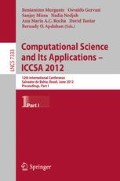Abstract
In this work we propose to build a set of binary logistic models that could assess the probability of success or no success in oral rehabilitation process taking into account some genetic factors, individual habits clinical and non-clinical factors.
The study was conducted in a retrospective evaluation and consisted of 155 subjects undergoing oral rehabilitation in the Northern region of Portugal. We evaluated multiple factors in the construction of binary logistic regression models. We have chosen the model that gave statistically better discriminating power between success and failure, through the value of area under the ROC curve. The model that reveals better performance was Model 4, with AUC = 0.789 and a 95% confidence interval [0.715;0.863].
Access this chapter
Tax calculation will be finalised at checkout
Purchases are for personal use only
Preview
Unable to display preview. Download preview PDF.
References
Braga, A.C.: Curvas ROC: Aspectos funcionais e aplicações. Tese Doutoramento. Universidade do Minho (2001)
Gruica, B., Wang, H.Y., Lang, N.P., Buser, D.: Impact of IL-1 genotype and smoking status on the prognosis of osseointegrated implants. Clinical Oral Implants Research 15, 393–400 (2004)
Hanley, J.A., McNeil, B.J.: The Meaning and Use of the Area under a Receiver Operating Characteristic ROC Curve. Radiology 143, 29–36 (1985)
Hosmer, D., Lemeshow, S.: Applied Logistic Regression. John Wiley & Sons (1989)
Metz, C.E.: Statistical Analysis of ROC Data in Evaluating Diagnostic Performance. In: Herbert, D., Myers, R. (eds.) Applications in the Health Sciences, vol. 13, pp. 365–384. American Institute of Physics (1986)
Misch, C.E., Perel, M.L., Wang, H.L., Sammartino, G., Galindo-Moreno, P., Trisi, P., Steigmann, M., Rebaudi, A., Palti, A., Pikos, M.A., Schwartz-Arad, D., Choukroun, J., Gutierrez-Perez, J.L., Marenzi, G., Valavanis, D.K.: Implant success, survival, and failure: the International Congress of Oral Implantologists (ICOI) Pisa Consensus Conference. Implant Dentistry 17, 5–15 (2008)
Swets, J.A., Pickett, R.M.: Evaluation of Diagnostic Systems Methods from Signal Detection Theory. Academic Press, London (1982)
Swets, J.A.: Signal Detection Theory and ROC Analysis in Psychology and Diagnostics. Collected Papers, New Jersey (1996)
Vaz, P., Gallas, M.M., Braga, A.C., Sampaio-Fernandes, J.C., Felino, A., Tavares, P.: IL1 gene polymorphisms and unsuccessful dental implants. Clinical Oral Implants Research, November 10 (2011), doi: 10.1111/j.1600-0501.2011.02322.x
Author information
Authors and Affiliations
Editor information
Editors and Affiliations
Rights and permissions
Copyright information
© 2012 Springer-Verlag Berlin Heidelberg
About this paper
Cite this paper
Braga, A.C., Vaz, P., Sampaio-Fernandes, J.C., Felino, A., Tavares, M.P. (2012). Decision Model to Predict the Implant Success. In: Murgante, B., et al. Computational Science and Its Applications – ICCSA 2012. ICCSA 2012. Lecture Notes in Computer Science, vol 7333. Springer, Berlin, Heidelberg. https://doi.org/10.1007/978-3-642-31125-3_50
Download citation
DOI: https://doi.org/10.1007/978-3-642-31125-3_50
Publisher Name: Springer, Berlin, Heidelberg
Print ISBN: 978-3-642-31124-6
Online ISBN: 978-3-642-31125-3
eBook Packages: Computer ScienceComputer Science (R0)

